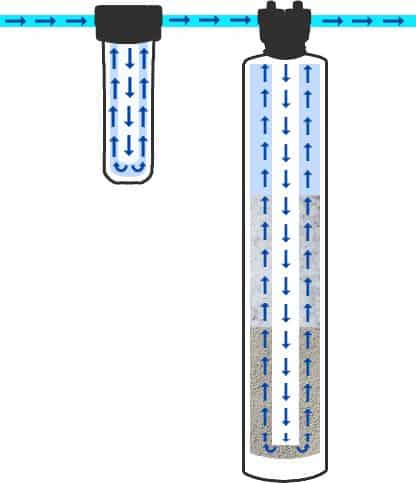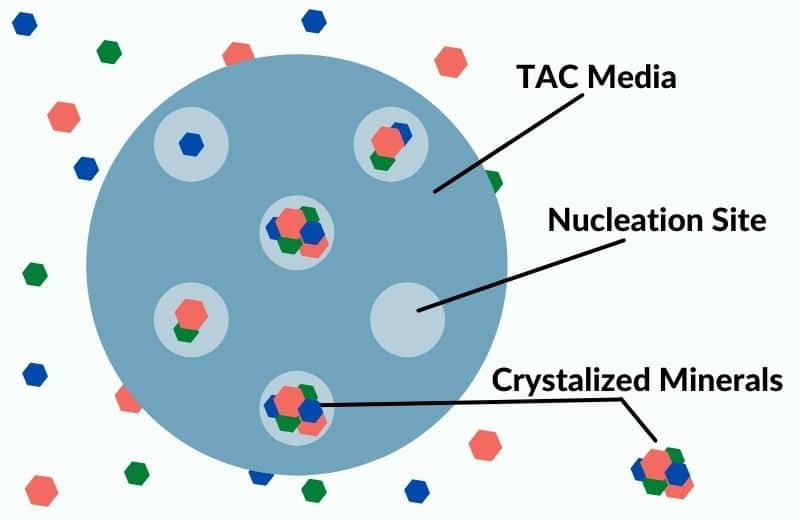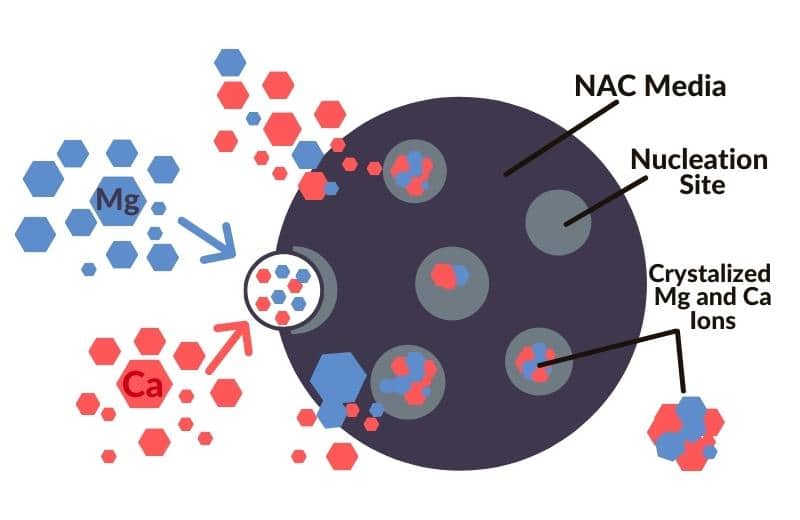Template-assisted crystallization (TAC for short) and nucleation-assisted crystallization (NAC) are two very similar salt-free water conditioning processes. If you’re considering a salt-free water softener, there’s a good chance that the system uses one of the two conditioning techniques.
Do template-assisted crystallization and nucleation-assisted crystallization work? The answer is yes, both technologies can be used to condition your water – and this article will explain the science behind these processes, and how they prevent scale formation in hard water.
Table of Contents
🚰 What is Salt-Free Water Conditioning?
Salt-free water conditioning is classed as a water softening process, but water isn’t technically softened using this method.
To understand how a water conditioner works, let’s first look at the traditional salt-based ion exchange water softening process. Calcium and magnesium, the two minerals that are responsible for scale, are completely removed in ion exchange water softeners.
During the ion exchange process, these hardness minerals are attracted to a softening resin, which contains sodium ions. When the hardness ions stick to this resin, they’re exchanged for sodium ions, which are released into water to balance out its charge. After this process is complete, water is classed as soft, because it no longer contains the minerals that cause scale.
Ion exchange water softeners provide water softening, while water salt-free conditioners provide water conditioning. Both methods result in scale prevention, but salt-free conditioning units don’t remove calcium and magnesium from water.

Instead, water conditioners alter the formation of hard water minerals, preventing them from being able to form scale. TAC, NAC, and several other, less popular methods of conditioning can be used in place of ion-exchange softeners or water filter systems that can remove hard water ions, like reverse osmosis.
When used for conditioning purposes in residential applications, salt-free water softeners have several advantages over traditional water softeners, including:
- A salt-free water softener is the more environmentally-friendly option because the system doesn’t waste water or regenerate – two essential requirements for salt-based water softeners.
- Additionally, salt-free water softeners don’t need salt, which helps you save money, reduces the frequency of maintenance, and is the better choice for people on a low-sodium diet.
- Finally, salt-free conditioning systems don’t actually remove hardness ions, despite preventing limescale formation. This means you can still enjoy the healthy natural mineral quantity in your water, which gives water a pleasant mineral taste.
The below sections provide more information about the template-assisted crystallization and nucleation-assisted crystallization processes.
🌐 What is Template Assisted Crystallization (TAC)?
Template-assisted crystallization changes the structure of calcium and magnesium minerals by having these minerals interact with a media inside the TAC conditioning chamber. How exactly does TAC water treatment work?
Template-Assisted Crystallization – The Process
A TAC media is made up of hundreds of very small polymer beads. When water flows through these beads, the calcium carbonate and magnesium ions stick to the media. Calcium and magnesium will continue to build up in the media and begin to convert into small micro-crystals.
The crystals break off from the media once they reach a certain size, flowing back into your drinking water. This happens on a consistent basis, so a measured amount of calcium and magnesium crystals are released during the conditioning water treatment process. You won’t end up with a large number of crystals in your water all at once.

In their new crystallized form, magnesium and calcium will remain in your water as it flows through your plumbing. The minerals are unable to leave water or stick to surfaces and cause scale, so the pipes and appliances in your whole house, including your tankless water heater and other water systems, will be free from scale using this process.
TAC doesn’t actually soften water, and you’ll still technically end up with hard water, but TAC still provides all the benefits of soft water. Because the water hardness ions are unable to form scale, you won’t experience the classic hard water problems, like reduced water pressure, restricted flow rates, white spots on your dishware, and difficult-to-clean hard water scale build-up.
Some manufacturers say that template-assisted crystallization can reduce existing scale formation, but there’s little evidence to support this information.
Template-assisted crystallization costs about the same as a salt-based softener upfront, but this water treatment system is more affordable in the long term because no salt or water waste is involved. Additionally, TAC maintains your water quality, so you can still benefit from healthy minerals in your drinking water.
Installation
Installing a TAC conditioner is generally easier than installing a water softener because there’s only one tank to install, and you don’t need to connect the unit to a drain line. You should install the conditioner at your home’s point of entry, before your tankless water heater, to prevent hard water scale damage to any of the appliances in your home.
Maintenance
TAC technology is virtually maintenance-free, but you will need to replace the media in TAC systems eventually. Most systems have media that can last for at least 6-8 years. After this, the technology will become ineffective in crystallizing hardness ions, resulting in limescale buildup.
🌀 What is Nucleation Assisted Crystallization (NAC)?
Template-assisted crystallization and nucleation-assisted crystallization are often referred to as the same thing, or even interchangeably, and this is because the process is virtually the same for both methods of water treatment.
Nucleation-Assisted Crystallization – The Process
There’s no evidence to suggest that TAC or NAC works better, so if a salt-free water softener uses an NAC media, it’ll provide essentially the same water conditioning as a TAC conditioner.
In fact, nucleation-assisted crystallization seems to be just another name for template-assisted crystallization. The name “nucleation-assisted” refers to the nucleation sites that are provided by the media beads inside NAC conditioning tanks. Again, this media transforms magnesium and calcium into micro-crystals that are unable to adhere to surfaces and form scale.

Like TAC, NAC releases the crystals back into the water, ensuring that water retains the same feel and pleasant alkaline taste. Sodium isn’t added to water, and the magnesium and calcium ions aren’t actually removed, so you’re still left with hard water that can’t form scale.
NAC provides scale prevention around your home, including in your tankless water heater and other appliances.
Installation
Installation of NAC water treatment systems is the same as installing a TAC system because both units consist of a single tank containing media.
Maintenance
NAC technology is just as cost-effective to maintain as TAC because it also doesn’t need salt, excess water, or any other regular maintenance to operate. Again, the media will need replacing after approximately 6-8 years.
In all, both of these conditioning techniques are an environmentally friendly alternative to the traditional water softening process.

Does this cause the KH to disappear thus allowing the pH to drop?
No TAC does not directly cause KH (carbonate hardness) to disappear, nor does it directly lead to a drop in pH
Water is the universal solvent, this is why water dissolves/pulls minerals into the water. TAC/NAC takes dissolved solids out of solution to make “Crystal seeds” (micro particles). In order for TAC/NAC to be effective, surfaces should be wiped down and because the deposits do not bind with the surface cleaning is far easier. Unfortunately aerators and showerheads or areas that retain moisture the water can dissolve the particles back into solution. Ultimately this is not as effective as ION exchange (traditional water softener). Every product has benefits and compromises. Proper education and qualifying the purchaser will be the only way to ensure meeting customer expectations. Water treatment professionals should not embellish on the capabilities of products they sell. To often terms like removal are used loosely when truthfully reduction should only be used. Too often removal is used even if a % is reduced from the water. That % is referred to as removal rate. Very misleading!
Great comment, right on point 👌
So regarding Jerrod’s comment of “In order for TAC/NAC to be effective, surfaces should be wiped down and because the deposits do not bind with the surface cleaning is far easier. Unfortunately aerators and showerheads or areas that retain moisture the water can dissolve the particles back into solution.”, does this mean that the if you have a glass shower enclosure that you should or will have to wipe down the glass after every shower to make sure that deposits to do appear on the glass as the particles go back into solution?
Thank you,
David
Hey David, great question. Yes, with TAC/NAC conditioning, because the minerals are still present they will still gather on surfaces and need to be wiped away. The best way to completely eliminate the issues caused by hard water is with an ion exchange water softener.
Has anyone looked at the cost of the TAC media? Culligan sells a unit and the media is more expensive than gold and according to them is only good for about three years. I would gladly substitute another manufacturer’s media for theirs as their pricing is egregious.
Are the crystals formed by the process harmful to kidneys/organs? Is your body processing it differently than just standard hard water?
This would be a great question for your healthcare professional.
“In fact, nucleation-assisted crystallization seems to be just another name for template-assisted crystallization.” Since the only difference is the name assigned to the technology, it would be nice if the industry settled on a single name – either one or the other – to describe the process and reduce the potential for consumer confusion.
100% agreed!